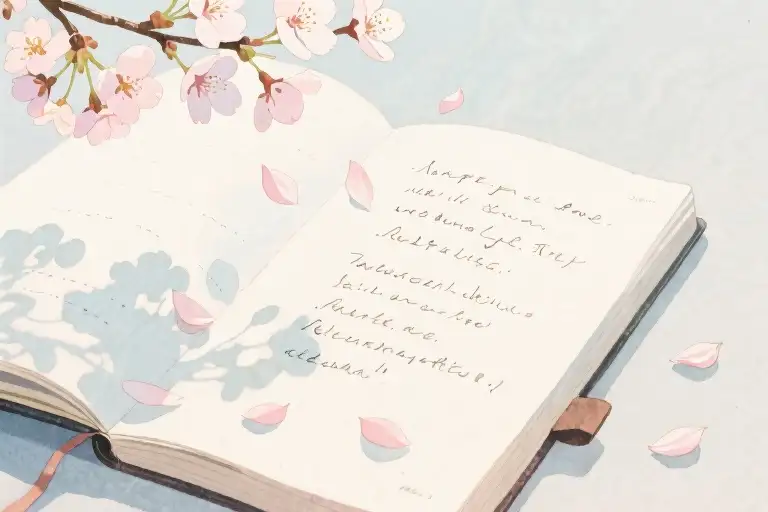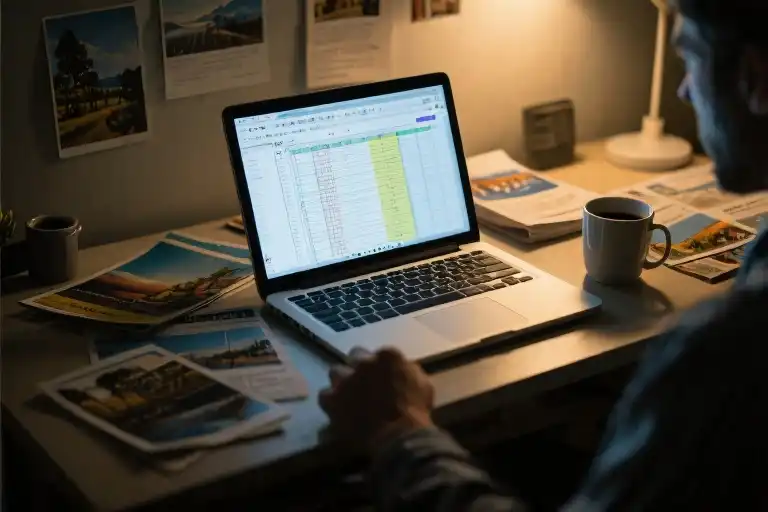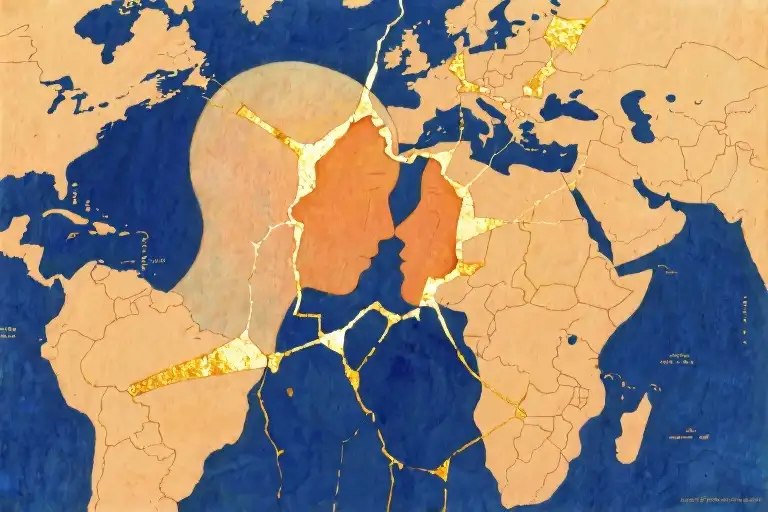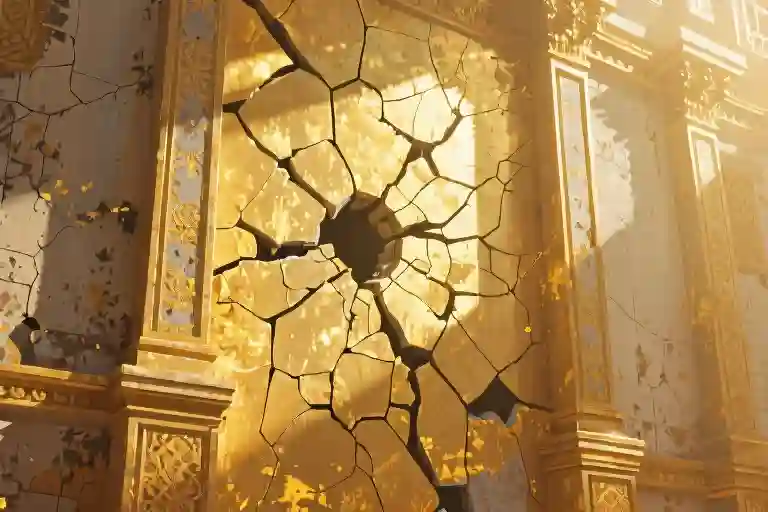The calendar flips to April again, and with it comes that familiar chorus – “Can you believe it’s April already?” People say it every year, this casual remark about time slipping through our fingers. But for me, April now holds a different weight. My personal timeline split in two last April, when I signed the separation papers from my husband of fifteen years.
Looking at my phone now, the digital calendar shows two significant dates marked in red: April 15, 2022 – the day we officially separated, and today’s date exactly one year later. Between these two points stretches twelve months that have reshaped how I see my entire relationship history – a continuous twenty-year chain of romantic attachments with barely a break.
Fifteen years of marriage. Five years of dating before that. Another three-year relationship immediately preceding, with only a fragile two-week bridge between that breakup and my first date with my future husband. Before that stretch of constant pairing, my high school and college years felt like an endless sentence of solitary confinement – though in reality, they were just normal stretches of being unattached that I experienced as personal failures.
During those earlier years, I navigated what we now call “situationships” – those ambiguous connections that are more than friendship but never quite become committed relationships. How I wish that term had existed back then! Instead, I interpreted every undefined connection as a failed relationship, assuming the lack of progression was always my fault. Too distant or too eager, never quite mastering the elusive art of flirting – the self-blame came easily and stuck hard.
This April, as the cherry blossoms fall outside my window, I’m learning to sit with these realizations rather than rush past them. The numbers tell their own story: 15 + 5 + 3 + 0.5 (those two weeks might as well be a rounding error in this calculation). Nearly two decades of back-to-back relationships with almost no space to breathe in between. What began as teenage fear of being single quietly shaped every romantic decision that followed, like invisible tracks guiding a train.
That first year of truly being alone since my teens has been equal parts terrifying and illuminating. For the first time, I’m examining not just my failed marriage, but the pattern that led me there – that relentless need to be partnered that left no room to discover who I might be on my own. The April sunlight feels different this year, not marking time lost but possibility gained.
The Archaeological Layers of Marriage
Fifteen years of marriage compressed into three Polaroid moments:
- The Night We Forgot to Fight
July 2008, our first apartment with the leaky faucet. You brought home tulips (“just because”) while I burned the lasagna. We ate charred pasta on the floor laughing, your socked feet nudging mine under the coffee table. This memory glows amber in my mental scrapbook—the before times when compromise felt like adventure rather than exhaustion. - The Silence Before the Storm
A Tuesday in 2016, your suitcase by the door for another business trip. My fingers tracing the rim of my wineglass as you scrolled through emails. The unspoken calculations: 37% resentful I handled school drop-offs alone, 22% guilty for minding, 41% relieved you’d be gone. Marriage math always carries remainders. - The Last First Kiss
April 2022, the accidental brush of hands when passing the divorce papers. Your cologne still the same since college, now layered with someone else’s laundry detergent. Twenty years collapsed into that split-second touch—all our beginnings and endings contained in the space between fingertips.
The Five-Year Audition
Our dating era exists in my mind as highlight reels and bloopers, none of the mundane B-roll:
Extreme Close-Up: The Fight That Almost Ended Us
That winter night you drove off after I threw your Xbox controller (“It’s just a game!” “That’s not the point!”). Three hours pacing our icy porch until headlights cut through the dark. You emerged holding two coffees and a new controller—your peace offering smelling of hazelnut and humility.
Wide Shot: The Yes Moment
Central Park 2003, you knee-deep in fallen leaves pretending to “trip” into proposal position. My squeal scattering pigeons as the ring caught September sun. That version of us lives forever in golden hour, untouched by mortgage statements or fertility clinics.
Psychologists call this selective memory pruning—our brains preserving emotional peaks while discarding the flatlining middles. What remains isn’t inaccurate, just… incomplete. Like judging a novel by its kissing scenes and climactic fights while skipping all the dialogue in between.
Relationship Relics (A Visual Interlude)
[Insert stylized timeline graphic showing:]
- 2000-2003: The Pre-Husband Relationship (3yrs 2mo)
- Transition Period: 2 weeks (highlighted in caution-tape yellow)
- 2003-2008: Dating Era (5yrs) → 2008-2023: Marriage (15yrs)
That thin yellow sliver between relationships still shocks me. Two weeks to dismantle a shared life, pack away photos, and—apparently—rewire my heart’s “occupied” sign. At 24, I mistook this for resilience. At 44, I recognize it as relationship hopping, that dizzying dance where you never let the music stop long enough to notice your blisters.
My therapist would later point out the obvious: “You built your identity around being someone’s someone.” The realization landed like a dropped casserole dish—messy, embarrassing, impossible to ignore. All those years spent curating my relationship resume (Dependable Girlfriend! Low-Maintenance Wife!) while my solo self atrophied in storage.
The Stories We Wear Smooth
We retell our love stories like worry stones, polishing certain edges while others go dull. Here’s what my retellings often omit:
- The way we stopped making eye contact during sex around year seven
- Your baffled expression when I confessed feeling lonely in our crowded house
- The 83 consecutive mornings we ate toast in silence before you left for work
These omissions aren’t dishonest, just human. Like museum curators, we rotate which artifacts go on display based on who’s visiting. For years, I showcased only the gleaming moments to friends (“We’re doing great!”) while the cracked pottery gathered dust in storage.
Key Insight: Long-term relationships aren’t one story but layered strata—each version true depending which level you excavate. The trick is acknowledging all layers exist simultaneously: the burnished golden memories and the corroded ones beneath.
The Two-Week Transition Experiment
That phone call lasted exactly 37 minutes. I know because I kept staring at the digital clock on my microwave while pressing the receiver against my ear, watching the numbers change from 8:13 to 8:50 PM. His voice crackled through the line: “I think we want different things” – a breakup line so cliché it stung more than actual cruelty would have.
What fascinates me now isn’t the breakup itself, but what happened during those fourteen days that followed. The way my brain immediately switched tracks like a train changing rails in the night. By day three, I’d already created a mental checklist:
- Delete photos (but save the good ones to a hidden folder)
- Return his sweatshirt (the navy blue one I’d secretly kept)
- Update dating profile (because everyone knows the recently single are most desirable)
The Psychology Behind the Rebound
My first date with my future husband occurred at a dimly lit Italian restaurant on September 17th – precisely two weeks after that microwave-clock breakup. Here’s what I remember most:
- The way I ordered spaghetti carbonara specifically because my ex hated creamy sauces
- How I laughed too loudly at his jokes while mentally comparing their shoulder width
- The relief when he reached for the check (proof I wasn’t damaged goods)
At the time, I called this “moving on.” Now I recognize it as relationship hopping – that compulsive need to fill emotional vacancies immediately, like applying fresh paint over water damage.
Three unconscious motives drove that two-week transition:
- The Validation Vacuum
Being chosen by someone new provided instant ego restoration. His text saying “Had a great time” temporarily silenced the “you’re unlovable” tape playing in my head. - Social Timeline Panic
At 26, my friend circle was entering the engagement phase. Two weeks single felt like falling behind in some invisible race where the prize was being normal. - Emotional Bypassing
Dating became a distraction tactic – why process grief when you can analyze a new man’s texting patterns instead?
The Situationship Bridge
Those fourteen days weren’t actually empty. I’d reconnected with an old flirtation (let’s call him The Interim) during week one. We existed in that gray zone now called a situationship:
- No labels but daily AIM chats (this was 2004)
- Physical intimacy but avoided eye contact in public
- Future talk limited to “We should try that new sushi place”
Modern relationship psychology would recognize this as a transitional attachment – a psychological stepping stone between significant relationships. But back then? I weaponized it against myself:
“Why can’t he commit? Must be because I…”
- Didn’t play enough hard-to-get
- Laughed at his dumb jokes
- Wore the wrong jeans that one time
Breaking the Pattern
Now, when coaching clients through breakups, I share what I wish I’d known:
Healthy gap periods aren’t blank spaces – they’re incubation phases where:
- Neural pathways reset (science shows it takes 3+ months to “deprogram” from a relationship)
- Self-concept rebuilds (who are you outside of “we”?)
- Relationship patterns emerge (track your dating history like stock market trends)
Try this instead of two-week turnarounds:
- The 90-Day Detox
No dating apps, no “let’s grab drinks” with that convenient backup person. Just you and your Netflix queue becoming reacquainted. - Relationship Autopsy
Map your last three relationships side-by-side. Notice any “groundhog day” similarities in how they started/ended? - Solo Date Challenge
Do the things you’d normally do with a partner – museums, nice restaurants, travel – alone until it stops feeling strange.
That frantic two-week transition taught me something vital: Grief avoided always collects interest. The loneliness I outran in 2004 compounded over fifteen years of marriage until it demanded payment – with divorce papers as the receipt.
Sometimes growth means staying in the empty space long enough to hear what it’s trying to tell you.
The Situationships We Didn’t Name
We called them ‘almost relationships’ back then. Those undefined connections that lingered in the gray area between friendship and commitment. Today, my therapist would call them ‘situationships’ – a term that somehow validates all those confusing emotions I carried alone in the 90s.
Situationship (n.): A romantic connection lacking clear expectations or commitments, often characterized by inconsistent communication and undefined status. Unlike casual dating, situationships typically involve emotional investment without mutual agreement about the relationship’s future.
The College Almost (1995)
I remember sitting cross-legged on his dorm room floor when he said, “I’m just not ready for anything serious right now.” My 19-year-old brain translated this as: “You’re not worth committing to.” For months afterward, I analyzed every interaction – was my laugh too loud at that party? Did I seem too eager when I suggested studying together?
Now I see what we really had: a classic situationship. We texted (well, actually called – this was 1995) daily, shared inside jokes, even met each other’s friends. But whenever I gently broached the ‘what are we’ conversation, he’d retreat. Back then, I assumed the problem was my approach. Today I recognize he simply wanted different things – and neither of us had the vocabulary to articulate that.
The Post-Grad Limbo (1999)
Then there was the finance guy who’d take me to fancy dinners but never introduced me to his colleagues. “My work friends wouldn’t understand us,” he’d say, swirling his merlot. I spent hours trying to ‘understand us’ myself, reading meaning into the flowers he sent after arguments but never the promises he avoided making.
Modern dating coaches would identify this immediately: emotional unavailability meets anxious attachment. But in 1999? I just thought I needed to be more ‘chill.’ So I perfected the art of playing it cool while dying inside – a skill that would later haunt my marriage.
The Rebound That Never Rebounded (2001)
Two weeks after my three-year relationship ended, I went on that fateful first date with my future husband. But between those two milestones was Chris – the sweet graphic designer who liked making mixtapes and talking about art. We kissed once, awkwardly, after a Neutral Milk Hotel concert. When I didn’t feel instant sparks, I panicked. “Maybe I’m broken,” I wrote in my journal. “Why can’t I just be happy with someone nice?”
What I couldn’t see then: I was using Chris as an emotional airbag, cushioning my fall between relationships. The discomfort I felt wasn’t about him – it was my body signaling I needed actual alone time. But ‘self-care’ wasn’t in our cultural lexicon yet, so I misinterpreted the unease as another personal failing.
The Patterns Emerge
Looking back, three themes emerge across these situationships:
- Instant Self-Blame: Every ambiguity became evidence of my inadequacy
- False Dichotomies: I assumed relationships were either ‘successful’ or ‘failed’ with no middle ground
- Vocabulary Deficit: Without terms like ’emotional availability’ or ‘attachment styles,’ I defaulted to 90s rom-com logic
A recent study in the Journal of Social and Personal Relationships found that women are 37% more likely than men to internalize situationship ambiguities as personal shortcomings. Reading this, I finally understood: those painful experiences weren’t proof I was bad at relationships – they were proof I was operating without a cultural framework that validated emotional complexity.
Reflection Exercise:
Think back to your pre-2010 dating experiences. Now try describing them using modern relationship terms. Does this reframing change how you view those moments? Share in the comments – I’ll go first: That college almost? Not a ‘failed relationship,’ but a mutually confusing situationship where we both deserved more clarity.
The Anatomy of Singleness Anxiety
That photograph from senior prom still sits in my mother’s hallway cabinet – the one where I’m perched on the edge of a decorated gymnasium bleacher, hands folded tightly over my lavender taffeta dress while couples twirl around me. My smile holds that particular strain of teenage girls trying to prove they’re perfectly content. Two decades later, I can still taste the metallic tang of panic that would rise when slow songs played, still feel the phantom weight of that disposable camera burning in my clutch, unused because there was no one to ask “Will you take our picture?”
This wasn’t just adolescent awkwardness. It was the first tangible evidence of what therapists now call chronophobia – not fear of time itself, but terror of being left behind by its passage. In the 90s, we lacked vocabulary for this specific flavor of anxiety, though the symptoms were everywhere: in the way my girlfriends and I analyzed every mixed tape from boys as if decoding the Dead Sea Scrolls, in the midnight dorm room interrogations where “So… have you done it yet?” carried the gravity of a final exam.
Three artifacts from my singleness anxiety museum:
- The Virginity Flowchart – A handwritten decision tree from college titled “How to Lose It Before Graduation” with increasingly desperate options branching from “Actually meet someone” to “That guy from chem lab (maybe if he wears contacts?)”
- The Backup Boyfriend List – Names scribbled in my senior yearbook margins ranked by “Most Likely to Date Me If Desperate” with helpful notes like “Likes same bands (but smells like ham)”
- The Time Capsule Letter – Seventeen-year-old me’s plea to future self: “I swear if you’re still alone at 25 just lie and say you’re a lesbian so people stop asking”
What fascinates me now isn’t the cringe-worthy content (though heaven knows there’s plenty), but the bone-deep certainty that being single constituted failure. This wasn’t entirely our invention – pop culture delivered daily reminders through teen movies where the prom queen’s crown sat precariously atop her boyfriend’s arm, through women’s magazines that paired articles like “Land Your Man Before Finals!” with quizzes calculating your “Relationship Expiration Date.”
Yet even as an English major deconstructing patriarchal narratives in class, I absorbed these messages at a cellular level. My journal entries from that period read like defective product reviews: “Too bookish for jocks, too sarcastic for nice guys – possibly defective model.” The cruelest twist? This self-assessment came during what was objectively my most “successful” dating period – three different situationships in six months! But without that modern framework, I interpreted the ambiguity as personal shortcomings.
That prom photo’s true secret lies in what’s outside the frame: the bathroom stall where I cried after “Stairway to Heaven” played for the third time, the calculus homework waiting in my purse because I’d convinced myself no one would ask a girl doing derivatives. Two decades of relationship hopping later, I recognize that moment as ground zero – when I internalized the equation Alone = Unlovable and began sprinting through connections like a tourist afraid to miss the last train home.
Perhaps you have your own version of that bleacher photo. Maybe it’s the empty chair at your cousin’s wedding reception, or the way you’d invent “boyfriends” during holiday small talk. These aren’t just embarrassing memories – they’re fossil records showing how early we learn to fear solitude. The miracle isn’t that we developed these survival mechanisms, but that we’re now brave enough to examine them under proper lighting.
Next week: The science behind why “just be happy single!” advice feels like telling someone to enjoy root canals – and what actually helps rewire those neural pathways.
The April Algorithm: Rewriting My Relationship Code
Twelve months of separation have given me something unexpected: a new lens to examine the past twenty years. Where I once saw isolated events—a breakup here, a flirtation there—I now recognize patterns as clear as bar codes. This April, instead of dreading the anniversary, I created something revolutionary (for me): a relationship timeline analysis.
The Three-Color Coding System
My kitchen table became an archaeological dig site last week. Armed with highlighters, I color-coded two decades of relationships:
- Yellow: Time actively partnered (15 years marriage + 5 years dating + 3 years previous relationship = 23 years)
- Pink: Situationships and ambiguous connections (that college summer fling, the coworker who always
“almost” asked me out) - Blue: Actual single periods (those infamous 2 weeks plus 3 months senior year of college)
The visual shock was profound. The yellow stripes dominated like highway lines, with thin blue cracks barely visible. That fragile 2-week bridge between serious relationships? It looked exactly like what it was—a panic-filled sprint.
The Downloadable Tool I Wish I’d Had
This exercise led me to create a simple template anyone can use (you’ll find the download link at the end). It asks three diagnostic questions:
- Duration Analysis: Calculate your partnered vs. single ratio over 5/10/15 year increments
- Transition Patterns: Note how you typically move between relationships (rebounds? deliberate pauses?)
- Situationship Audit: List connections that didn’t fit traditional labels—then revisit them with today’s wisdom
A client who tried this template had an epiphany: “Seeing that I’d spent 93% of adulthood partnered explained why dating apps terrified me—I’d never developed solo survival skills.”
Breaking the Autopilot
What my colorful timeline revealed was an unconscious algorithm:
IF relationship_ends THEN
FIND new_person WITHIN 14_days
ELSE self_worth -= 20%This April, I’m rewriting the code. My new version looks something like:
WHEN relationship_ends THEN
CREATE art_space
SCHEDULE friend_dinners
ALLOW grief_cycles
NOTE: New connections may emerge AFTER 90_daysYour Turn: The Relationship Timeline Challenge
I’m sharing my template not as a prescription, but as an invitation. When you map your own history, you might discover:
- That “crazy busy” year when you mysteriously had no dates (turns out you were actually thriving at work)
- How cultural messages shaped your transitions (remember when every rom-com implied rebound sex was therapeutic?)
- The hidden situationships that taught you more than any official relationship
Download the Relationship Timeline Worksheet (PDF with fillable fields)
This April, the cherry blossoms outside my window aren’t measuring my progress or failure. They’re just being trees. And for the first time in decades, I’m just being human—no algorithm required.
The April That Changed Everything
This April feels different. While the world obsesses over time passing too quickly – “Can you believe it’s April already?” – my calendar holds a quieter, more personal milestone. Twelve months since the papers were signed. Twelve months since the life I knew for fifteen years of marriage (plus five years of dating) officially became past tense.
Looking back at my relationship timeline feels like reading a novel where the protagonist keeps making the same mistake. Three years with my college boyfriend, then a mere two-week gap before meeting my future husband. Before that? A string of undefined connections we’d now call situationships – though back then, we just called them heartbreaks that were inevitably my fault. Too distant or too eager, always somehow wrong in my approach to love.
The Weight of Empty Spaces
What strikes me now isn’t the relationships themselves, but the terrifying emptiness between them. Those two weeks between serious partners? They felt like freefall. The single years in high school and college? A social death sentence. I remember sitting alone at junior prom, watching couples sway under disco lights, convinced my worth was measured in dance partners.
We didn’t have the vocabulary then to name what I felt – this fear of being single that shaped every romantic decision. Today’s teens have terms like “situationships” and “attachment styles” to frame their experiences. We had Seventeen magazine quizzes: “How to Keep a Boy Interested!” and “10 Flirting Tricks That Work!” The unspoken message: If you’re alone, you’re failing.
Rewriting My Relationship Code
This past year forced me to confront my own relationship patterns. Using a simple three-color timeline (blue for relationships, red for transitions, yellow for growth periods), I mapped twenty years of romantic history. The visual was shocking – nearly solid blue with just thin red slivers. Had I ever truly been alone?
Now when cherry blossoms drift past my window this April, I don’t count them like calendar pages slipping away. That tree has outlasted my marriage, will outlast my healing. There’s comfort in that.
Your Turn:
- What does your relationship timeline reveal?
- Where do you see patterns emerging?
- Share one surprising turning point in your comments below.





